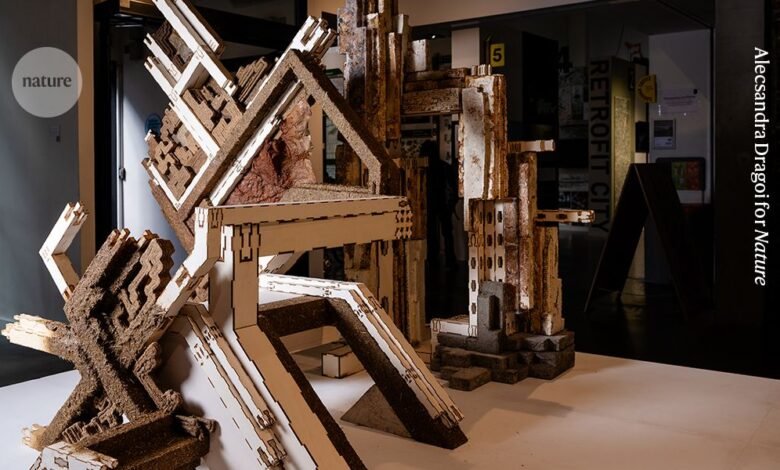
Living materials
Colomina compares modern architecture to antibiotics. Just as the widespread use of these drugs has driven antibiotic resistance, architecture has “created its own monsters”, she writes in The Architectural Review. There is evidence that autoimmune diseases, allergies and metabolic diseases, such as obesity, are influenced by the microbes that people are exposed to, and that the diversity of these microbes is decreasing.
Architecture, she argues, should instead be more like the human gut: porous and diverse. But bringing the wild inside is easier said than done. Microbes and architecture can make an uneasy pairing, says Beckett. Architects try to design for permanence and stability, but microbes are “unruly”, he says. “They don’t always behave.”
A probiotic surface designed to host microbial communities in a building. Credit: Richard Beckett/Beckett Lab
A probiotic surface designed to host microbial communities in a building. Credit: Richard Beckett/Beckett Lab
One approach is to integrate environmental microbes into building materials. Beckett, who studied biochemistry and worked as a researcher at the UK pharmaceutical company GlaxoSmithKline before becoming an architect, hopes that benign microbiota incorporated into the built environment might outcompete or repel drug-resistant pathogens. Antimicrobial resistance is a major public-health concern, estimated4 to have been involved in nearly five million deaths in 2019.
To try to overcome this, Beckett has worked with microbiologists on a project called Niches for Organic Territories in Bio-Augmented Design (NOTBAD).
The NOTBAD team chose as its model pathogen a strain of methicillin-resistant Staphylococcus aureus (MRSA) that can repel many antibiotics and has become a scourge in hospitals. The team’s benign microbes were strains of the soil bacterium Bacillus subtilis that have shown antimicrobial properties in the lab and can survive in dry indoor conditions.
Richard Beckett worked at a pharmaceutical company before becoming an architect. Credit: Alecsandra Dragoi for Nature
Richard Beckett worked at a pharmaceutical company before becoming an architect. Credit: Alecsandra Dragoi for Nature
The next task was choosing a material that could incorporate the benign microbes. Beckett’s work draws on the concept of bioreceptivity: the ability of a material to be colonized by living organisms. This idea, which draws together materials science and ecology, reframes such colonization — moss or algae growing on a stone monument, for example — in a positive or neutral way, rather than viewing it as a destructive process. “Some materials are receptive to microbial growth,” says Beckett, and to him that isn’t a bad thing.
Smooth materials that lack pores, such as glass, are generally not bioreceptive. Lab-made materials, such as squishy water-filled polymers called hydrogels, are very bioreceptive, but they’re only available in small pieces, and are not durable enough for architectural use.
The NOTBAD team has explored several materials, including 3D printed plastics, aluminium and various formulations of concrete as a medium for B. subtilis. The team tested whether the microbes were viable in each material, then assessed whether the microbe–material composite repelled MRSA.
The NOTBAD team tested several formulations of concrete before opting for a ceramic material. Credit: Beckett Lab
The NOTBAD team tested several formulations of concrete before opting for a ceramic material. Credit: Beckett Lab
A ceramic-based material performed best, inhibiting growth of the pathogen. The material is relatively sturdy and has rough surfaces and pores that can hold moisture and act as microbe-friendly niches.
The living ceramics could be used to make tiles for indoor use. “We are positioning ourselves against the glazed white tiles of laboratories — we look to challenge that,” says Beckett.
For now, it is just a proof of concept. It’s not clear whether a B. subtilis population would remain viable over the life of a building without maintenance, such as water or nourishment. It’s also unclear whether the bacteria would be distributed throughout an indoor environment over time — and if that were to happen, whether this would be beneficial or harmful. The microbe is prevalent outdoors and is harmless to most people, but there are rare instances of B. subtilis infection in older people or those who are immunocompromised.
Source link




